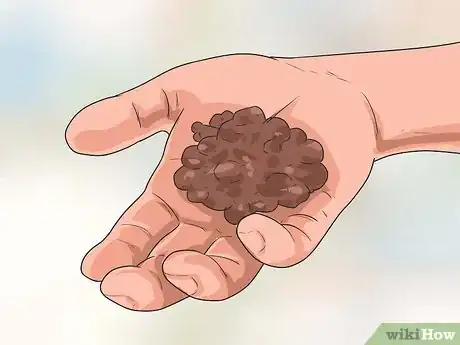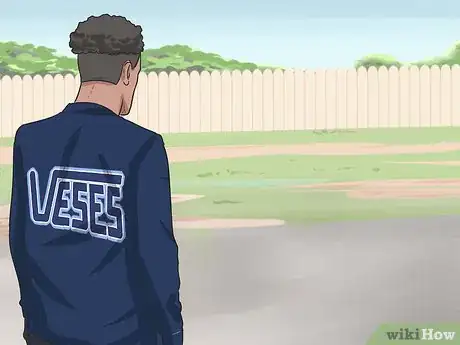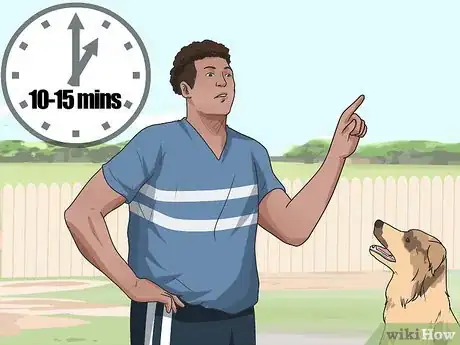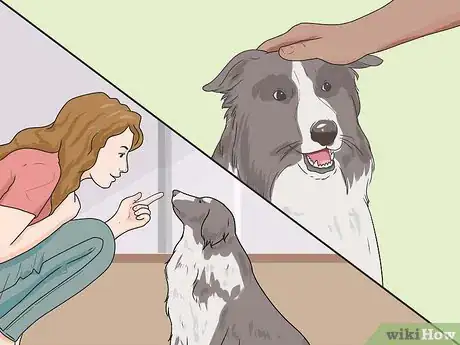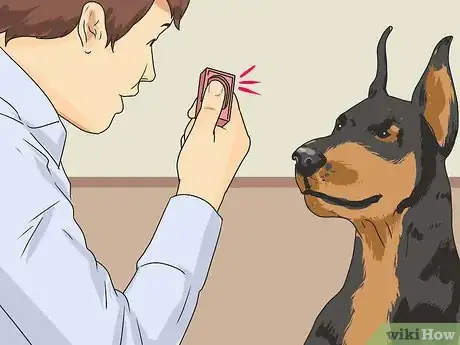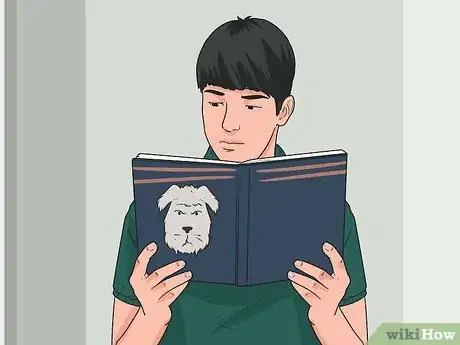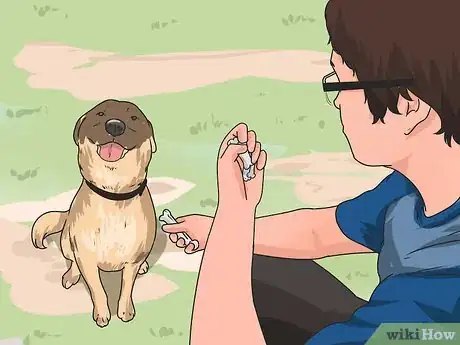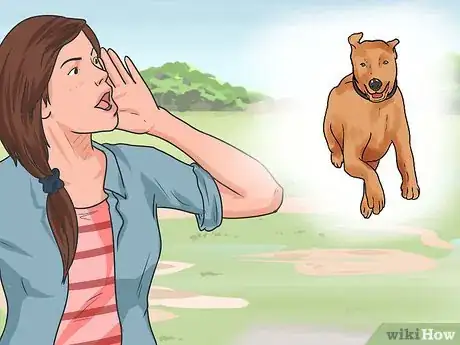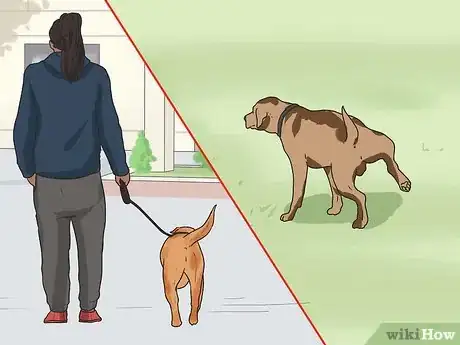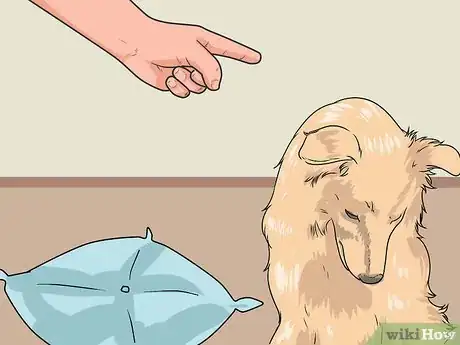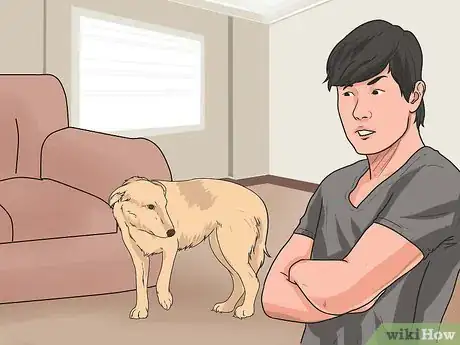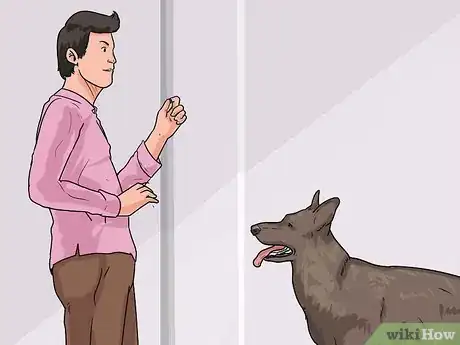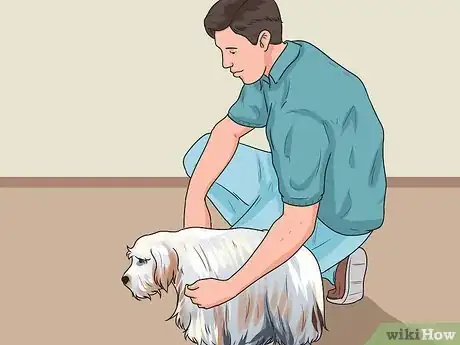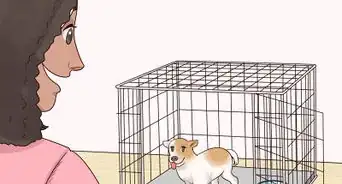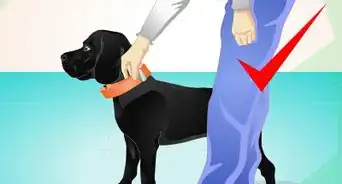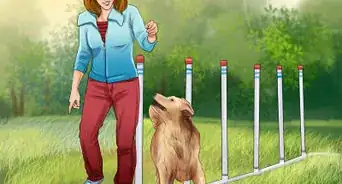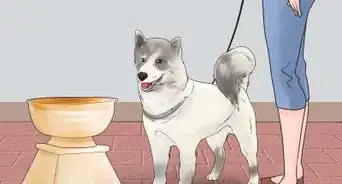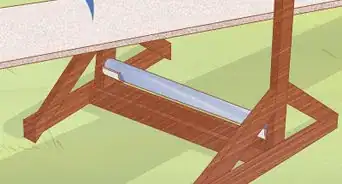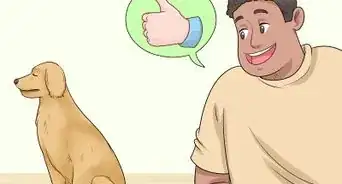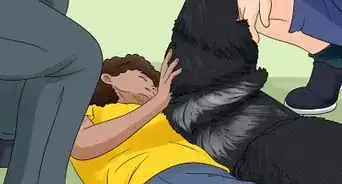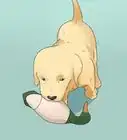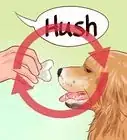This article was co-authored by David Levin. David Levin is the Owner of Citizen Hound, a professional dog walking business based in the San Francisco Bay Area. With over 9 years of professional dog walking and training experience, David's business has been voted the "Best Dog Walker SF" by Beast of the Bay for 2019, 2018, and 2017. Citizen Hound has also been ranked #1 Dog Walker by the SF Examiner and A-List in 2017, 2016, 2015. Citizen Hound prides themselves on their customer service, care, skill, and reputation.
wikiHow marks an article as reader-approved once it receives enough positive feedback. This article received 13 testimonials and 90% of readers who voted found it helpful, earning it our reader-approved status.
This article has been viewed 307,878 times.
It is important to train your dog, whether small or large, young or old. Besides helping it behave better, training a dog will improve its relationship with you. In addition, training a dog what it can and cannot do, and to always respond to your commands, ensures its safety. For example, it could save your dog from being hit by a car if it ever escapes or gets lost.
Steps
Preparing to Train Your Dog
-
1Get some treats that your dog likes. Take small pieces so that you can give it one for each thing it does without worrying about your dog getting fat. Some dogs, especially Labradors and Beagles, are extremely food orientated, and so you can set aside a portion of their daily kibble into a treat pouch, and use this to reward them.
-
2Choose an environment with few distractions, such as your backyard. Don’t have toys out unless they are for training. You want the dog to listen to you, rather than watching other dogs having fun in the park. During the early stages of training, when you aren't sure of your dog's response, keep your dog on a leash. This saves unnecessary shouting to get its attention if it starts to wander off. Instead, just gently reel your dog in.[1]
- Once your dog has learned basic commands like sit, stay, and heel, then you can continue lessons with distractions - indeed this is beneficial because it helps him understand you expect to react under all circumstances, rather than just in the yard.
Advertisement -
3Keep training sessions relatively short to begin with. A typical training program involves two daily sessions of 10 - 20 minutes each. Also reinforce commands by asking the dog to "sit" before meals, or "stay" when you go to get his or her lead.[2]
- Different dogs have different attention spans, (just as human personalities differ so do dogs). However, some breeds are more trainable, meaning they have strong powers of concentration. These include German shepherd dogs, Border collies, Labradors, and dogs that were originally bred as hunting dogs.
-
4Be realistic about the speed of progress. Yes, you can teach an old dog new tricks, but it takes longer. Don't expect him to pick things up as quickly as a young puppy within their socialization period. However, do not be discouraged if progress is slow. Stay focused and be patient with your dog and yourself as you train it![3]
Deciding What Type of Training You Want to Use
-
1Use reward-based training methods. Some training methods advocate out-and-out dominance of the dog, and whilst it's good to be a leader to your dog, it should be based on encouragement rather than harsh correction. Think of your dog as a junior family member who needs to live by the house rules for everyone's benefit.
- Reward based training works on the principle of rewarding good behaviors so that the dog wants to repeat them in order to get a treat, whilst bad behavior is ignored, so the dog gets not benefit from it and the behavior eventually stops as a result.[4]
-
2Learn how to use clicker training, as it is an excellent method for training dogs. This is covered in depth at How to Clicker Train your Dog . The principle is to teach the dog to associate the click-clack of the clicker with a reward or treat. Then you give a cue word and use the clicker to mark the exact moment a desired behavior takes place,, and then reward.
- The advantage of using the clicker is that it's a down-payment on a treat, and so can exactly mark the desired behavior in a way that's difficult to do otherwise.[5]
-
3Never use a choke chain. They're cruel and not only will your dog probably not like you very much, the choke chain could do irreparable damage to your dog's neck. In fact, dogs have died as a result of wearing choke chains.
- A choke chain, prong collar, or electric collar represent lazy or shoddy training. They rely on fear of pain to subdue a dog and make it fearful, rather than encourage it to chose the correct behavior upon request.[6]
-
4Do some research on dog training. Borrow and buy books on dog training from your local library and your local bookshop. Read books and articles about dog training, behavior, and psychology so that you understand how dogs think, which gives you a vital edge when training them.
-
5Do not shout at or hit your dog. Be aware that scolding a dog rarely has a place in dog training. Dogs live in the present and if you scold a dog it just links the negativity to you, and becomes wary of you, rather than learning a lesson, which can damage your relationship. On occasions when you are present and wish to correct behavior, such as the dog on the sofa, use a disapproving facial expression and a disapproving noise, to show you are not happy, but punishing by shouting or physical violence achieves nothing other than to damage your bond.
- Aggression often incites a fear response in dogs, not a true trained response. If you hit a dog too much or too harshly, he or she can become nervous of hands approaching it. So when a child goes to stroke the dog, all the dog sees is the same hand that hit it approaching. He or she is scared and thinks "Is this person going to hit me today?" So the dog bites out of fear.
- Dog training is not about today, it’s about tomorrow. You don’t need behavior to start or stop right this very instance as much as you need it to continue or end completely in the future.[7]
Teaching Basic Commands
-
1Start by training your dog to "sit." Building a solid "sit" command places you in control of a whole variety of situations. For example, if your dog hears the doorbell and rushes to bark, you can interrupt this behavior by asking it to sit, then rewarding the "sit," and removing the dog to a back room where it won't bark.
- To teach sit, show the dog you have a treat in your hand. Show it the treat at nose level, then arc the treat up above its nose. Say "sit." Your dog's head will follow the treat, leading their head to go up and it's bottom to go down. The moment their bottom hits the ground, click-clack the clicker and give it a reward.[8]
- Once your dog is doing this regularly, start to skip the treat. This builds unpredictability in the dog's mind about whether he or she gets a reward or not and stops it taking them for granted. This means the dog works harder. Eventually, just reward every fourth or fifth command.
- Once your dog is sitting regularly on command, ask him or her to do this when out and about, before putting its food down, and at the curbside before crossing a street.
-
2Teach your dog to stay on command. Stay is taught in a similar way to "sit". Get the dog in a sit first, then take one step away. Say "stay", and when the dog doesn't move, click-clack and reward, plus give it lots of fuss. Gradually increase the distance, until you are eventually able to leave the room without the dog moving.[9]
-
3Teach recall. To teach recall, start in a small space, so the dog is never terribly far away. When it turns and takes a step towards you, give a cue "here." As the dog continues moving toward your click-clack, and when it arrives, give him or her a big fuss and a treat. Keep repeating this, until the dog understands what you want it to do. Tell it to come whenever you feed it or under any other circumstance that it will come to you regardless.
- Make coming to you a good thing for your dog. Be excited, and reward often. Start with short 'come' distances and be sure to release the dog quickly to go to what it was doing.
- Recall is a commonly the cause of much confusion for dog and owner alike. The problem is that it's human nature to reprimand the dog when it eventually comes to you after 30 minutes of calling it. This teaches the dog that when it comes, you get cross, and therefore the dog would really rather not come back at all. Telling the dog off gives him or her conflicting instructions. Instead, no matter how long it takes, always be pleased to see your pet and make a big fuss of him or her.[10]
- Once the dog has mastered the command in a small room, try it in the yard. A word of warning though, unless you are completely confident of your dog's recall don't let him or her off leash in the park. Keep the dog on a long line so that you can reel it in if it doesn't obey.
-
4Train your dog to go to the bathroom outside. If the dog is poorly house trained, then go back to basics and retrain in the same way you would teach a puppy. Give the dog plenty of exercise, and then back home keep him confined to a small room or a crate (teach him to love the crate. How to Crate Train your Puppy ) Take him outside every hour, and when he squats or relieves himself, say the cue word "Potty" or "toilet" and when he's finished give him a big reward. Also do this first thing in the morning and last thing at night. Eventually he will realize it's a super easy way to get a treat, is to spend his bladder and bowel contents in a particular place in order to earn a treat.
- If he does have an accident in doors, don't scold him or tell him off. Instead, calmly clear it up using an enzymatic clear, so there are no scent clues left for him to return to the spot. Avoid using household cleaners, especially those containing bleach, since ammonia is part of urine and you can unwittingly reinforce the smell. [%]
-
5Teach your dog to leave items alone. To teach the dog to "drop it", start with something the dog may pick up but that isn't his or her all time favorite toy. Let the dog pick the object up, then offer it the ultra tasty treat in return. Your pooch has to drop the object to get the treat, so as its jaw relaxes its grip say "drop it." Click as the dog drops the toy and give it the treat. Keep repeating this as with other commands.
- Once trained, if you come across something that you do not want your dog to eat and it seems interested, tell the dog to leave it alone. Praise it when it switches its attention towards you.
- While training the dog, remove temptation from his or her path. However, if the dog does pick something up, especially if it could potentially harm it if swallowed, then push on its cheeks near the back of the jawbone and praise it for dropping it. Again, never use force to pry a dogs mouth open to retrieve something unless its dangerous, like medicine of something sharp.
-
6Teach your dog to stay off furniture. If your dog climbs on furniture or jumps on you without permission, tell it to get off in a scolding manner and praise it when it does. If necessary, shove it off the furniture. If it jumps on you without permission, make a disapproving noise and move your knee forward to bump it. Keeping a lead attached in the house is also a good way of removing the dog, but without getting in danger if he is inclined to snap when removed from furniture. Limit the verbal interaction until the dog is down.
-
7Teach your dog to stay off of people, even when it is excited to see someone. To teach a dog to get down, use treats and a command, such as "off". If this doesn't help, use a canister of compressed air that has a motion trigger, in front of the furniture, so the dog gets a remote punishment when he goes to jump up.
Taking Special Conditions into Consideration
-
1Remember that you are training an adult dog that already has a lifetime of experiences. Training is a life-long process and something that should be ongoing no matter what the age of your dog. However, if you have rescued an adult dog, or realised your dog has got into bad habits, then you need to know the best way to go about training an adult dog.
-
2Take medical conditions into consideration. A good start is to get the dog checked out by your veterinarian. This allows you to be aware of any limitations the dog has, and also if they are health issues that could explain problems with obedience.
- For example if the dog refuses to sit, it might be the she or he has painful hips, which can make sitting difficult to do. The answer is then to start pain-relieving medication and to consider an alternative command such as "stand."
- In addition, if the adult dog seems wilfully disobedient, it can then be salient to learn that they are deaf, and therefore not hearing your commands. Knowing this can then let you change to hand signals, instead of verbal commands, for the dog to respond to.[11]
-
3Take the time to understand your adult dog and know what makes him or her tick. For example, if the dog is aggressive with strange dogs, is that as a result of fear or guarding territory? Knowing the trigger can help you retrain more effectively, by building his self-confidence around other dogs or removing toys that he is territorial about.
- If he keeps running away, but he's an unneutered male, then getting him desexed can really help.
- Work out what areas of your dog's training are weak so you can target those areas. Does he have a specific bad habit that needs to be addressed, or could his training just use some general sharpening up?
- If his responses are excellent, then look at teaching him some tricks. Training is an excellent way to bond with your dog and help him to understand you are in charge. In fact, training a grieving dog can help distract them and ease their grief, as they enjoy the one-to-one time with their owner and it helps feel secure that you are in charge.[12]
Expert Q&A
Did you know you can get expert answers for this article?
Unlock expert answers by supporting wikiHow
-
QuestionHow do you get a stubborn dog to listen?
 David LevinDavid Levin is the Owner of Citizen Hound, a professional dog walking business based in the San Francisco Bay Area. With over 9 years of professional dog walking and training experience, David's business has been voted the "Best Dog Walker SF" by Beast of the Bay for 2019, 2018, and 2017. Citizen Hound has also been ranked #1 Dog Walker by the SF Examiner and A-List in 2017, 2016, 2015. Citizen Hound prides themselves on their customer service, care, skill, and reputation.
David LevinDavid Levin is the Owner of Citizen Hound, a professional dog walking business based in the San Francisco Bay Area. With over 9 years of professional dog walking and training experience, David's business has been voted the "Best Dog Walker SF" by Beast of the Bay for 2019, 2018, and 2017. Citizen Hound has also been ranked #1 Dog Walker by the SF Examiner and A-List in 2017, 2016, 2015. Citizen Hound prides themselves on their customer service, care, skill, and reputation.
Professional Dog Trainer
-
QuestionHow do you discipline a dog that won't listen?
 David LevinDavid Levin is the Owner of Citizen Hound, a professional dog walking business based in the San Francisco Bay Area. With over 9 years of professional dog walking and training experience, David's business has been voted the "Best Dog Walker SF" by Beast of the Bay for 2019, 2018, and 2017. Citizen Hound has also been ranked #1 Dog Walker by the SF Examiner and A-List in 2017, 2016, 2015. Citizen Hound prides themselves on their customer service, care, skill, and reputation.
David LevinDavid Levin is the Owner of Citizen Hound, a professional dog walking business based in the San Francisco Bay Area. With over 9 years of professional dog walking and training experience, David's business has been voted the "Best Dog Walker SF" by Beast of the Bay for 2019, 2018, and 2017. Citizen Hound has also been ranked #1 Dog Walker by the SF Examiner and A-List in 2017, 2016, 2015. Citizen Hound prides themselves on their customer service, care, skill, and reputation.
Professional Dog Trainer
-
QuestionHow do I train my dog to bark only when commanded?
 Pippa Elliott, MRCVSDr. Elliott, BVMS, MRCVS is a veterinarian with over 30 years of experience in veterinary surgery and companion animal practice. She graduated from the University of Glasgow in 1987 with a degree in veterinary medicine and surgery. She has worked at the same animal clinic in her hometown for over 20 years.
Pippa Elliott, MRCVSDr. Elliott, BVMS, MRCVS is a veterinarian with over 30 years of experience in veterinary surgery and companion animal practice. She graduated from the University of Glasgow in 1987 with a degree in veterinary medicine and surgery. She has worked at the same animal clinic in her hometown for over 20 years.
Veterinarian First, teach your dog to bark on command. Once he has mastered this, you can teach him the opposite command "Quiet" by rewarding his silence and giving it a cue word. To teach him to bark on command, knock on a wall to trigger him to bark. Praise him, label with a cue word such as "Speak" or "Bark," and reward with a treat.
First, teach your dog to bark on command. Once he has mastered this, you can teach him the opposite command "Quiet" by rewarding his silence and giving it a cue word. To teach him to bark on command, knock on a wall to trigger him to bark. Praise him, label with a cue word such as "Speak" or "Bark," and reward with a treat.
References
- ↑ Don't Shoot the Dog. Karen Pryor. Ringpress Books
- ↑ Train your Dog Positively. Victoria Sitwell. Ten Speed Press
- ↑ David Levin. Dog Training Coach. Expert Interview. 19 December 2019.
- ↑ Don't Shoot the Dog. Karen Pryor. Ringpress Books
- ↑ Don't Shoot the Dog. Karen Pryor. Ringpress Books
- ↑ Don't Shoot the Dog. Karen Pryor. Ringpress Books
- ↑ David Levin. Dog Training Coach. Expert Interview. 19 December 2019.
- ↑ Don't Shoot the Dog. Karen Pryor. Ringpress Books
- ↑ Don't Shoot the Dog. Karen Pryor. Ringpress Books
About This Article
To train an adult dog, start with simple, basic commands like “sit.” When your dog performs the correct behavior, reward it with a treat and lots of praise. Once your dog masters a command, give the rewards less often so that it doesn’t take the treats for granted. If your dog needs to be potty trained, take it outside every hour, or as often as possible. After your dog relieves itself, reward it with a tasty treat in order to reinforce the behavior with a positive result. For more advice from our Veterinary reviewer, including how to teach commands like “stay” and “come,” keep reading.
